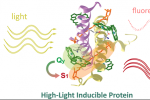Article in prestigious Nature Chemical Biology
Southbohemian researchers from Czech Academy of Sciences and Southbohemian university published their results in highly respected periodical Nature Chemical Biology. The article named „Mechanism of photoprotection in the cyanobacterial ancestor of plant antenna proteins" describes molecular mechanism for protection of photosynthetic organisms against excessive light. Among authors of the publication is Tomáš Polívka from Biology centre, Institute of Plant Molecular Biology.
http://www.nature.com/nchembio/journal/vaop/ncurrent/full/nchembio.1755.html
Abstract
Plants collect light for photosynthesis using light-harvesting complexes (LHCs)—an array of chlorophyll proteins that are able to reversibly switch from harvesting to energy-dissipation mode to prevent damage of the photosynthetic apparatus. LHC antennae as well as other members of the LHC superfamily evolved from cyanobacterial ancestors called high light–inducible proteins (Hlips). Here, we characterized a purified Hlip family member HliD isolated from the cyanobacterium Synechocystis sp. PCC 6803. We found that the HliD binds chlorophyll-a (Chl-a) and β-carotene and exhibits an energy-dissipative conformation. Using femtosecond spectroscopy, we demonstrated that the energy dissipation is achieved via direct energy transfer from a Chl-a Qy state to the β-caroteneS1 state. We did not detect any cation of β-carotene that would accompany Chl-a quenching. These results provide proof of principle that this quenching mechanism operates in the LHC superfamily and also shed light on the photoprotective role of Hlips and the evolution of LHC antennae.












